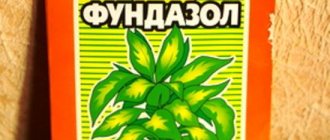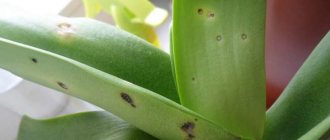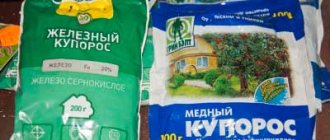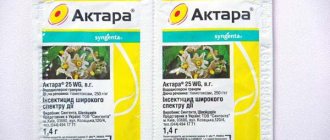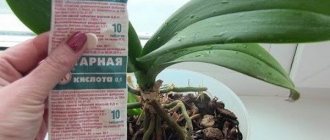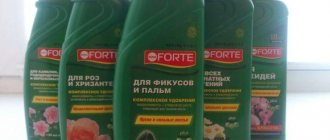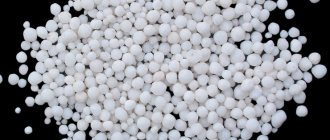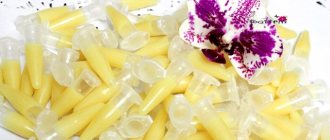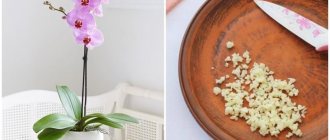Loading…
Gorgeous orchids are the pride of flower growers, and it’s especially disappointing when they start to get sick. Today we will talk about all the subtleties of how to use Fundazol for orchids. This is a very effective drug, but at the same time quite strong. If you get carried away with a fungicide, you may not only not help the plant, but even completely destroy it. In addition, its use is not always effective, because the product has its own specification.
Fundazol is a systemic fungicide. Description, purpose and composition of the drug
Plant protection products are called fungus killers . If you translate the word fungicide. Life does not stand still. Pathogenic organisms adapt to many drugs. They develop resistance to their damaging components.
Fundazol protects the orchid from various diseases.
Experts come up with new ones and improve those already proven in practice.
Combined products are created. Including, developing immunity in plants to pathogens . They are not so easy to understand even for experienced gardeners. Not to mention newbies. After all, the patient is serious. And dear. Orchid!
Classification of fungicides
By composition and origin:
- Inorganic chemicals : Copper-containing;
- Sulfur-containing;
- Compounds of iron, mercury, zinc, borax and others.
By purpose of use:
- Preventative;
- Immunizing;
- Medicinal.
According to the operating principle:
- Systemic drugs . Penetrate into the plant system and circulate with juices;
- Contact . They act as a barrier against pathogens. Or they directly act on the lesions.
There are different types of these drugs:
- Simple;
- Combined with other fungicides, insecticides, fertilizers and retardants.
For indoor plants, fungicides are used for immunization . More often when signs of disease appear or when treating already affected plants.
Fundazol first appeared in the USA.
Fundazol is one of the most famous fungicides:
- It was developed in the USA more than 30 years ago. For processing planting material at seed factories;
- But even in our time, flower growers still use it for the prevention of diseases and for their treatment of plants: For treating seeds and tubers before planting;
- For watering contaminated soil;
- For spraying plants during the growing season.
- Benleith;
- Pesticide, fungicide;
- Suppresses the ability of fungal spores to reproduce;
Fungicide Fundazol: analogues and substitutes
There was an opinion that the drug Fundazolom was in the prohibited category. It is included in the preparations, which can be viewed on the Ministry’s website, and can be freely used for treatment. It is quite difficult to find this product in specialized stores, and you can buy fakes on the shelves.
For this reason, it is necessary to use analogues and substitutes. They are presented in a fairly wide range.
Among the analogues of Fundazol, the following products can be distinguished:
- Ferazim is a systemic fungicide that perfectly eliminates fungus, based on carbendazim;
- Fitosporin is a fairly well-known and time-tested drug, which contains simply a huge amount of bacteria that have a beneficial effect on plants;
- Fitosporin - M - an improved drug that fights fungi and bacteria, is environmentally friendly;
- Topsin-M fights many diseases;
- Vitaros is a systemic fungicide, mainly intended for disinfection of planting bulbs, tubers, based on thiram and carboxin;
- Derosal is used to treat planting material, as well as the root system, green mass, protecting plants throughout their growing season;
- Maxim is a contact-type fungicide based on fludioxonil.
- Trichodermin is a biological, absolutely safe product that removes many types of bacteria and at the same time enriches the soil.
All of the listed drugs are complete substitutes for Fundazol. Finding them on sale is much easier.
How to replace Fundazol - video
Compatibility with other drugs, analogues
In parallel with Fundazol, growth stimulants, fungicides, pesticides, and insecticides are often used. However, mixing alkaline agents with the drug is prohibited.
To check the compatibility of plant preparations, a small amount of both preparations should be mixed in a small amount of water. If sediment forms as a result, then these products cannot be combined to treat plants.
If it is impossible to purchase Fundazol, it can be replaced with one of the following drugs: Fundazim, Fitosporin, Ferazim, Topsin-M, Derozal, Vitaros.
In addition, you can protect cultivated crops from diseases using a folk remedy such as activated carbon.
Analogues of the drug
Currently, the highly effective Fundazol has a number of fairly effective analogs that are successfully used in gardening, vegetable growing and floriculture:
- Ferazim is a popular antifungal drug;
- Fitosporin is a drug that has a mild effect and contains components beneficial to plants;
- Vitaros is a preventive disinfectant for planting and seed material, as well as a good remedy against fungal infections;
- Derosal is a fungicidal agent with a very wide spectrum of effects on pathogenic microflora.
One of the most popular analogs of “Fundazol” in our country is the drug “Topsin-M”, which is characterized by universal insecticidal activity of triple action.
Fitosporin is a drug that has a mild effect and contains components beneficial to plants.
Release forms. Hazard Class
White or cream powder
- Can be purchased in various packages. Small packaging is convenient and practical for flower growers. 10, 20 grams per package. After all, the prepared solution should not be stored for a long time;
- Fundazol belongs to the second class of danger for mammals. This is quite a high level. Reminds me of Carbendazim and Fundazim. For birds and bees, its danger is classified as class 3-4. But its effectiveness outweighed its danger. And it was used;
- The duration of the protective effect is from 7 to 20 days;
Fundazol is a white powder that must be dissolved before use.
- What to replace : Vitaros;
- Topsin-M;
- Fitosporin;
- Fundazim;
- Derosil.
Security measures
The stability of the drug is characterized as long-term. Therefore, after treatment, precautions are taken for at least 7-10 days (after inspection, wash hands and use protective equipment).
Hazard class – 2. This indicates an increased toxic effect on all living organisms. It is dangerous for allergy sufferers to carry out any activities with Fundazol: it causes an allergic reaction in the form of skin rashes and swelling of the mucous membranes. It has a strong effect on the reproductive system and is slightly soluble in liquid and soil. Complete disintegration occurs within six months.
It is strictly forbidden to apply the product to soil that is close to water bodies. The minimum permitted distance is 2.5 kilometers. All preparatory work takes place in the fresh air, wearing protective clothing, away from residential buildings. The product is especially dangerous when used by a woman during pregnancy.
After working with the drug you should:
- dispose of items that were used for processing;
- wash your hands under running water;
- take a shower;
- drink up to 400 ml of milk. This liquid acts as a neutralizer.
If the working solution gets on your skin or mucous membranes, go to the hospital for help. First aid is provided by washing the damaged areas in manganese or salt water. Be sure to provoke a gag reflex and take intoxication neutralizers.
Precautionary measures
The hazard class of the drug Fundazol for humans is 2 (highly toxic substance), for bees - 3-4 (moderately toxic substance).
As mentioned above, precautions must be taken when working with the drug.
Photo rules for precautions when using the drug
Such events include:
- use of protective equipment for hands, eyes, respiratory tract: gloves, goggles, respirator;
- when the work is completed, you must wash your hands thoroughly with soap (if possible, take a shower) and rinse your mouth well;
- During treatment with the product, it is strictly forbidden to eat, drink, or smoke;
- If possible, it is worth spraying the surrounding area in which the product was treated with plain water.
Attention!
You should not use Fundazol for residential premises. Such products as Trichodermin, Bioreid, Gaupsin, Fitosporin are more suitable.
Pros and cons of the drug Fundazol - video
Advantages and disadvantages. Differences from other drugs
For a long time, flower growers have been choosing it because of its advantages and benefits :
- Versatility and wide range of applications;
- Penetrates the plant quickly and immediately acts on diseases or pests. Within 2-3 hours after treatment, the spread of the disease is inhibited. Pathogenic microflora is completely blocked within 24 hours;
- Does not depend on temperature . Protective properties are maintained at high and low temperatures;
- After a short time (about 3 hours), rains are not dangerous for him;
- The toxicity level is not high;
- Bulbs treated before planting provide plant protection throughout the growing season.
Fundazol has both its advantages and disadvantages.
Consider the disadvantages of this fungicide:
- Do not store or use near open fire. The composition is highly flammable;
- Quite dangerous for humans. And pet fish;
- It cannot be used often. Experts advise using it on one area only after 3-4 years.
From the history of the foundation:
- Its use is being abandoned in America. The reason for this is the persistent resistance of pathogenic fungi to benzimidazoles (which includes the foundationazole itself). And harmfulness. As it turned out, for bees too;
- In Russia, the registration period for this drug expired in 2014. But it is being produced. And they use it. So do some other drugs (DNOC, Nitrafen).
Advantages
That is, the drug can simultaneously act as a nematicide, insecticide, acaricide, and fungicide. "Fundazol" has a number of advantages compared to other products:
- Has a low degree of toxicity.
- Blocks the growth and development of fungal symptoms within a day after using the product.
- Guarantees long-term protection of plant crops after its use for seed treatment.
- It is allowed to be used both for medicinal purposes and as a prophylactic agent.
- Valid at any temperature.
- Resistant to wet precipitation for three hours after treatment.
- Quickly penetrates the plant and affects the pest or spreading disease.
- Has a wide range of applications.
Few people know what Fundazol is.
Expert opinion on the preventive use of Fundazol
There is another subtle point regarding the use of Fundazol, which some experts mention:
“In my practice, I have come across the fact that flower growers use very strong chemicals to prevent infections. For some reason, “Fundazol” is especially popular, which is considered almost a panacea for all orchid ills. This is a serious mistake. For preventive purposes, you need to use simple and harmless biofungicides or, in extreme cases, non-systemic drugs. And “Fundazol” is an eradicating agent. If you just pour it on your orchids, in the future you can breed resistant strains of fungi in your flower garden, which will be very difficult to get rid of.”
A. Davydovskaya, owner of the greenhouse
Instructions for use of the drug
How to prepare a solution. Dosage selection
Detailed instructions for using Fundazol are presented below.
How to dilute the drug correctly? How much and how to dissolve the drug? It completely depends on the tasks that you have to solve:
- For spraying - one concentration: 10 grams per 10 liters of water.
- 10 grams per 1-2 liters of water.
- 10-15 grams per 10 liters of water. This is enough to process 20 sq.m.
The most ordinary water can be used. It is better to use warm for faster dissolution. No more than 2 times.
Precautions when preparing the solution
You must work with fungicide carefully. And follow safety precautions. Both when preparing the solution and when treating plants. Especially when spraying. The active ingredients require this :
- Special shoes and clothing;
- Respiratory mask and protective gloves;
- It is better to refrain from processing indoors;
- And it is not recommended to eat at this time. Even smoking is contraindicated;
- Dissolve only in special containers for this purpose;
- And follow simple personal hygiene measures. Wash with soap and rinse your mouth. Thoroughly.
Application of "Fundazol" by spraying and watering
The official regulations for the use of Fundazol provide only two ways to use the drug - spraying on the leaves and watering. However, orchids can be processed by another method - immersion of the root system.
Before processing, a working fluid is prepared from a wettable powder:
- 1 g of the drug is measured, poured into a jar and filled with 1 liter of water at room temperature;
- the mixture is thoroughly stirred to obtain a homogeneous suspension.
The concentration of the working fluid for spraying, immersion and watering is the same. After preparation, it is used immediately:
| Processing method | Instructions |
| Spraying | The working fluid is poured into a spray bottle. The orchid is sprayed from bottom to top along the leaves, trunk or pseudobulbs. |
| Watering | The working fluid is poured into a watering can. The pot with the orchid is placed on a tray and “Fundazol” is poured over the wet substrate at the rate of 1 glass per plant. |
| Dive | The working fluid is poured into a bowl. The orchid, freed from the substrate, is immersed with its roots in “Fundazol” and kept for 10-15 minutes. There is no need to rinse the roots with water after this. |
A control test is carried out 2 weeks after the first treatment. It must be performed even if the orchid shows signs of recovery after the first procedure. There is no need to treat the plant with Fundazol more than twice.
If after the first treatment the disease continues to progress noticeably, you need to think about changing the drug.
Tip #1. Benomyl disperses through tissues from bottom to top, but not vice versa. This direction of distribution of the substance is called acropetal. This means that with “Fundazol” it is better to treat the orchid below the site of infection rather than above.
"Fundazol" is used to treat orchids only in liquid form. It is strictly not recommended to pour dry powder into the substrate.
Purpose and properties
The drug Fundazol is used to treat plants from a variety of infections and diseases, the development of which is provoked by pathogenic fungi. The fungicide is also used for preventive treatment of plants, as well as for treating seeds before sowing.
The drug is successfully used not only on most agricultural crops, but also on ornamental and indoor plants. According to the instructions, weather conditions do not interfere with processing, so Fundazol can be used in various regions of the country with any climate.
Benomyl quickly penetrates the plant structure, moving along the foliage and roots of the crop. In this case, part of the substance settles on the surface of the plant, creating a protective white coating.
Effectiveness and Ineffectiveness
Due to its strong, fairly rapid action (its waiting period is 3-5 days) and long-lasting protective effect (see below), the fungicide Fundazol is quite popular. However, its possibilities are not limitless.
Preparations with benomyl, including Fundazol, are quite effective against harmful fungi of the genera Cladosponum, Colletotrichum, Cylindrocarpon, Fusarium, Marssomia, Phialiphora, Rhistoctonia, Sclerotinia, Septoria, Verticillium, etc. Externally, they manifest themselves in leaf spotting, powdery mildew , gray and white dry rot, mildew of decorative and construction deciduous trees, see fig.
External signs of fungal plant diseases against which Fundazol helps
Reviews
Elena P. “I haven’t used this drug for a long time. After I learned in detail about its properties. For orchids, it is suitable only in case of severe root disease. When they are very rotten. A paste of powder is prepared. All damaged and dried roots are cut off.
The remaining roots are lubricated. The use of foundation is one-time only. After all, it slows down growth. Plants develop slowly after its use. They may not bloom.”
Anastasia L. “I always have foundation in stock. Not so often, but you have to deal with driven roots. Especially after buying brand new orchids. I give them all the opportunity to adapt themselves for 2-3 weeks.
Fundazol is very popular among buyers.
And more often you have to replant. I take a good look at them. I remove all damaged and diseased ones. I will treat the cuts with activated carbon. I prepare porridge from foundationazole powder. I coat all the roots with a brush. I let it dry for a couple of hours. I coat it again. Only then do I plant it in my container.”
Sergei Mironov. “An old and proven remedy against many diseases. Even many representatives of the microflora have developed a protective reaction. Gardeners continue to use it out of habit. I wouldn’t recommend it for orchids either.
Only in situations where there are problems with the roots. It is not suitable against downy mildew and rust. More effective drugs are quite enough now. Especially for owners of a small number of orchids in the apartment. The same Topsin-M. And another piece of advice. Don't let your orchids get into this state. To use foundationazole."
Nikolay Samarin. “I’ll tell you something about Fundazole. They talk about its acaricidal (against ticks) and nematicidal (against small worms) effects. So here it is. This has not been confirmed by any studies. Some people succeeded. According to their stories. Or self-deception. Or a good coincidence.”
The use of "Fundazol" in the form of a slurry: pros and cons
In practice, orchid lovers very often use Fundazol in a way not provided for by the regulations - in the form of a paste. This paste is prepared as follows:
- take a tablespoon of powder;
- add water little by little, stirring with a wooden skewer;
- achieve a creamy or kefir-like consistency.
The product prepared in this way is taken with a brush and smeared onto the infection-damaged areas of the orchid. This technique is especially often used to treat rotten and cut roots.
This method has many supporters who believe that the pulp from Fundazol is a wonderful remedy against the spread of infection. However, this method of use raises doubts not in terms of effectiveness, but in terms of safety.
Elevated concentrations of benomyl have a depressing effect on plants. In no case should you smear the green organs of orchids with the paste - leaves, pseudobulbs, peduncles. The “coating” method can be justified only in one case – when the plant has completely lost its roots and dies from infection.
Coating with Fundazol pulp is a radical measure, advisable only in very severe cases when other methods have failed to stop the spread of infection. In all other situations, it is better to refrain from such use of the drug.
Advantages and disadvantages of "Fundazol"
Humanity has not yet come up with a perfect fungicide. Even Fundazol has two sides to the coin.
Pros:
- the product is absolutely harmless to crops;
- the treated seed is 100% protected from fungi;
- immediate effect on pathogenic microorganisms;
- rapid penetration into the internal structures of the plant;
- the ability to be used as a therapeutic and prophylactic agent;
- The degree of protection is not reduced even in bad weather.
Minuses:
- the fungicide is very flammable;
- highly toxic and therefore dangerous for humans, fish and other fauna;
- requires strict adherence to instructions, especially when processing seeds.
Methods of using the drug:
Seed dressing
Planting material is processed immediately before planting:
- Before planting, seeds are bathed in the prepared suspension (10 grams per 300-400 grams of water) for about 15 minutes. And allowed to dry;
- In 2-3 hours, using a good sprayer, the bulbs laid in one row are sprayed with a solution of 10 grams per 2 liters;
- You can also treat it using the method of short-term immersion in the prepared solution. Let them dry. And plant it.
Watering the substrate
Many orchid diseases can be caused by soil conditions . Not quite the correct selection and ratio of substrate components for a particular orchid does not allow the plant to develop well. The soil must be replaced every 2-3 years.
Treatment of the substrate allows you to neutralize overwintering disease spores . After watering the substrate, it must be dried. And only after that use it when transplanting.
Fundazol is not used in powder form for sprinkling soil.
Important! When watering the soil, the drug is not absorbed by the roots. Only affects soil.
Is it possible to spray leaves during the growing season?
This drug is rarely used for spraying vegetating orchids . Especially in a private house or apartment. To do this, use less toxic drugs.
Leaves are rarely sprayed with foundationazole.
Compatibility with other drugs and fertilizers
Many growth stimulants and insecticides can be mixed for simultaneous use with foundationazole:
- Zircon;
- Epin and others.
Attention!
- Alkaline preparations cannot be used to prepare tank mixtures with foundationazole. Drugs from the benzimidazole or thiophanate group;
- Including alternating their use.
Precautions when working with the drug
to prepare a working solution from foundationazole powder . It is more convenient to work with small packages. To avoid calculating the powder to water ratio:
- We poured a little less than half of the required water into the container;
- Empty the contents of the package;
- Stir until dissolved;
- Add water to the required volume;
- Let it sit for a bit and use.
Water requirements for preparing the solution:
- The most ordinary water can ;
- Better warm and settled;
- For faster dissolution.
Overdose:
- It is better to make a concentration greater than what is written in the instructions. Many gardeners and gardeners think so. Considering my experience;
- This should not be done with orchids. Everything is better in moderation! An overdose for orchids can only do harm . Consider the properties of this fungicide. It's already quite toxic.
Shelf life of the prepared solution:
- the prepared fungicide solution immediately ;
- After 3-4 hours, the mixture you prepared begins to lose its properties .
How to use Fundazol for orchids: methods of treating plants
The fungicide is available in the form of a soluble powder. Based on it, a working solution is prepared (1 g of the drug per 1 liter of water) and orchids are treated with it in one of the following ways:
- Leaves, stems, and bulbs are sprayed. If the disease is advanced and the orchid's roots have already rotted, you can use an emergency method. Make a paste from the powder by adding a little water. Apply this mixture to the remaining rosette or remaining roots, cleared of rot. It is strictly forbidden to treat healthy leaves, bulbs and peduncles.
Do not exceed the recommended dosage and frequency of flower treatments. The fungicide, although good, is very strong. It will kill the fungus, but the orchid itself may stop growing and blooming. Repeated treatment is carried out no earlier than after 2 weeks. If necessary, Fundazol can be combined with Fitosporin.
How to treat phalaenopsis with Fundazol - video
“>
Features of use
Benomyl spreads in plants only along the xylem in the acropetal direction, i.e. from the roots along the stem to the leaves through the vascular system that carries nutrients. Fundazol penetrates parasitic fungi primarily through their feeding appendages with suckers-haustoria. Fundazol does not spread through the phloem (the vascular system that removes plastic substances from photosynthetic organs). The integumentary tissues of plants and fungi are little permeable to benomyl. Second, benomyl is very poorly soluble in both water and most organic solvents. The “solution” of the drug is actually a suspension, a thin suspension. Further, Fundazol has little effect on fungal hyphae. And another feature essential for practice is the cumulative phytotoxicity of the drug. Up to a certain concentration, Fundazol is not phytotoxic, but its accumulation in the soil leads to plant inhibition - decreased yield, increased sensitivity to adverse conditions and diseases. Based on this, the use of Fundazol for plants is carried out taking into account the following. circumstances:
- The drug is most effective in the initial stages of the disease, when the fungal covers have not yet become stronger;
- Spraying with Fundazol is not very effective: the mushrooms will be affected only where the drug hits, and then weakly;
- The working “solution” of Fundazol greatly wears out the sprayer even with a special suspension nozzle, because the mechanical hardness of crystalline benomyl is quite high;
- If Fundazol is nevertheless used by spraying, then, contrary to the usual rules, it is better to carry it out in the morning on a sunny day (benomyl is light-resistant), when the roots and xylem are working with might and main;
- Application of Fundazol is effective by watering the soil. But at the same time, due to its high stability in the soil, the drug accumulates in it. Which, by the way, was warned about in the instructions for the first batches by the developers;
- Young shoots and, especially, peduncles from the treated plants must be removed - they will strongly draw the current through the xylem and transfer benomyl to the fruits, and almost no poison will reach harmful mushrooms;
- You also need to remove leaves that are heavily affected by the disease: the drug will not respond well to “mature” mushrooms, and again the poison will have little effect on sensitive young colonies.
Properties and instructions for use of the fungicide
To correctly calculate the dosage of Benomid fungicide, you should carefully read the instructions for use. Spray the freshly prepared solution onto the plants during the growing season in the morning or evening. They do this very carefully, trying not to expose crops growing nearby to chemicals.
| Processed crops | Type of disease | Consumption rate of Benomyl | Working substance consumption rate | Waiting time |
| Winter wheat and rye | Fusarium snow mold, Cercosporella root collar rot, Fusarium root rot, Ophiopathic root rot | 0.3 - 0.6 kg/ha | 300 l per 1 ha of area | 50 days |
| Spring wheat | Powdery mildew | 0.5 - 0.6 kg/ha | ||
| Sugar beets intended for industrial processing | Powdery mildew, cercospora | 0.6 - 0.8 kg/ha | 400 l per 1 ha of area | from 20 to 40 days |
| Seed dressing | ||||
| Winter and spring wheat | Loose smut, smut, cercosorella root collar rot, fusarium root rot, fusarium snow mold | 2-3 kg per 1 ton of grain | 10 liters per 1 ton of grain | — |
| Oats | Head smut, covered smut, fusarium root rot | |||
| Winter rye | Fusarium snow mold, fusarium root rot, stem smut | |||
| Winter and spring barley | Head smut, stone smut, false head smut, fusarium root rot |
Benomid solution is used to treat all types of grains against root and fusarium rot, snow mold and cercosporella root rot. Spring wheat is sprayed with a chemical composition against loose smut. Sugar and red beets are also treated at the first signs of powdery mildew and cercospora blight.
Growing grain crops require one-time spraying. All types of beets are processed several times.
The fungicide for humans has a second class of danger, and manual work on the site can only be started after a decade. Work using mechanisms is carried out after four days. If you exceed the prescribed dosage, you can harm some varieties of earthworms.
The drug prevents the development of root infections for a long time. It stays on the foliage for a long time, providing protective functions without affecting the bacteria that are beneficial and necessary for crops. Among other things, some pine tree nurseries are sprayed with Benomyl to prevent seedlings from lodging.
Purpose of "Fundazol" and pathogens sensitive to the drug
The spectrum of action of benomyl is quite wide, but limited. It is used to treat many plant diseases, but there are pathogens against which Fundazol is powerless:
| Orchid diseases that can be treated with Fundazol | Orchid diseases that cannot be treated with Fundazol |
|
|
Since Fundazol is a fungicide, it cannot be used to treat viral or bacterial lesions. Orchids suffer from bacterial infections no less often than from fungal infections, so novice orchid growers need to learn to distinguish between these types of diseases.
Advantages and disadvantages of Fundazol
The strengths of the fungicide are:
- high efficiency against many pathogens;
- direct impact on the source of infection without causing harm to cultivated plants;
- guaranteed protection of seed material from fungal infection, regardless of weather and air temperature;
- the composition of the drug, in which insecticidal, nematicidal and acaricidal components are added to enhance the positive effect;
- the ability to reduce the activity of pathogenic fungi immediately after contact with plants;
- increased stickiness, resistance to washing off by rain and water during irrigation.
The negative effect of the fungicide is expressed in the following properties:
- the possibility of toxic effects on humans, animals, bees, fish;
- high degree of flammability.
Recommendations for use
"Fundazol" is a very effective drug, but high efficiency can only be achieved with proper use.
Consumption rates and number of procedures
The dosage of the drug depends on the object of treatment:
- affected plants – 10 g per 10 liters of water;
- seed – 10 g/l;
- land for planting - rationing is similar to infected crops.
To disinfect the rhizome, gardeners recommend preparing an ointment by diluting a little dry chemical with water. Author's advice
The number of treatments directly depends on the disease:
- seed mold – one-time use;
- bulb rot - twice;
- withering - similar;
- ashtray - at least three times;
- spotting - four times.
Table: Drug consumption rates
Seed dressing
Seed material can be processed at any time: before or before sowing. To achieve the greatest effect, gardeners advise adhering to some rules:
- The seeds need to be filled with fungicide and left for a quarter of an hour. Then place them on a paper towel and let them dry.
- If it is necessary to pickle the bulbs, they should be sprayed with a solution of Fundazol at the rate of 10 g per two liters of water.
- Before planting, tubers are usually soaked for 15-20 minutes using a diluted preparation.
Processing of vegetable and horticultural crops
As already noted, the number of procedures and normalization depends on the type of crop being processed. Let's take a closer look at this point:
- Ornamental plants are sprayed 4 times.
- For fruit trees, 5 treatments are recommended before flowering.
- Berry crops will be saved by 2 procedures carried out before the buds open.
- Tomatoes and cucumbers are sprayed at the first signs of disease.
- To prevent cabbage from clubroot, it is enough to treat the soil for planting once.
- To avoid potato contamination, it is recommended to soak the tubers in a fungicide before planting.
- Bulb crops are processed in a similar way.
Orchid processing
Very delicate orchids react sensitively to potent drugs. However, they can also be treated with Fundazol:
- Cut off the top of a plastic bottle to make a kind of pot.
- Pour dry soil after mixing it with polystyrene foam.
- Moisten the resulting substrate with a chemical diluted with water.
- Replant the flower.
Protection of flowering ornamental plants Treatment of garden crops Protection of grapes Spraying of garden crops
The mechanism of action of the drug Fundazol
The effectiveness of the action is to stop the growth of fungi and their vital activity, due to the disruption of nuclear division of pathogenic organisms. It makes no difference how the drug gets onto the plant - through foliage, stems, roots or seeds.
The result of the fungicidal action can be observed already three days after treatment. The protective function lasts for a week, which is also indicated in the instructions.
Important! Not everyone knows about the acaricidal ability of benomyl - it suppresses not only adult spider mites, but also the eggs they lay. The product has a detrimental effect on leaf beetle larvae and aphids, as well as their eggs.
Based on the instructions for use, Fundazol is used to treat the following pathologies:
- pythium and phanomycete root rot;
- Alternaria blight;
- fusarium and helminthosporium root rot;
- powdery mildew;
- ascochyta;
- anthracnose;
- gray rot;
- wet rot;
- molding of seeds;
- stem smut;
- silver scab;
- smut;
- rhizoctanio;
- fusarium;
- snow mold;
- blackleg.
The drug is used to treat ornamental plants, agricultural and garden crops, shrubs and fruit trees, berries and flowers.
Attention! Compliance with the dosage specified in the instructions for use will protect plants from the toxic effects of the drug. Although the product is not phytotoxic, increased doses may have a detrimental effect on treated crops.
The fungicide can be used not only in spring, but also in autumn. It is effective over a wide temperature range, as reflected in the instructions.
Description and characteristics of the drug
It is not for nothing that “Fundazol” has earned high marks among gardeners. Unlike other fungicides, this product can be used to treat seed material, thereby significantly reducing the risk of plant infection.
The product belongs to the class of benzimidazoles, where the main active ingredient is benomyl. In the chemical composition of “Fundazol” its content is 500 g per 1 kg of the drug.
The chemical is available in powder form and is a white or pale yellow substance. The smell is specific, faint. There is no fugacity. Hazard class – 2.
"Fundazol" is available in powder form
The product can be safely called universal. It is used for processing:
- garden ornamental plants;
- vegetables;
- fruit and berry crops;
- indoor flowers;
- agricultural fields.
When used correctly, the effectiveness of the fungicide is very high. Therefore, before use, you need to carefully read the instructions, which detail the dosage.
The action of the chemical is directed towards the entire plant. It is able to stop the development of fungal diseases at their initial stage. The active substance blocks the proliferation of spores in a short time, eliminates symptoms, and promotes rapid regeneration.
The chemical blocks the development of fungal diseases at an early stage
As soon as benomyl comes into contact with the external tissues of plants, it immediately penetrates into the internal structure. The protective effect lasts from a week to a month, depending on the pathogen.
As a fungicide, it prevents fungal spores from spreading and reduces their number to zero. Acaricidal properties are manifested in the protection of crops from spider mites. The insecticidal effect is aimed at blocking the activity of leaf beetles.
The chemical is also used as a nematicide. It destroys nematodes, preventing microscopic worms from parasitizing the plant.
Application
Fundazol can be used to treat or prevent infection of garden crops by pathogenic microorganisms. In addition to the fact that the drug is an effective fungicide, it also has the following beneficial properties:
- reduces and suppresses the activity of spider mites - both larvae and adults;
- inhibits the development of leaf beetle larvae;
- destroys microscopic worms that damage the root system and above-ground parts of plants.
In order for the product to bring maximum benefit to the garden, you should strictly follow the instructions for its use.
Preparation of solution and dosage
The method of preparing the working solution of Fundazol depends on what diseases and on what crops it is planned to be used:
- when plants are affected by gray rot, powdery mildew, scab or spotting, the recommended dosage of the drug is 10 g per 10 liters of water;
- when cabbage is infected with clubroot, the correct dosage is 10-15 g of fungicide per 10 liters of water.
The prepared solution cannot be stored, so it is necessary to dilute the drug in such a volume that it can be used in one treatment. Before diluting Fundazol, you should definitely check the expiration date of the drug.
Expired fungicide should not be used under any circumstances.
Toxicity and precautions
The drug "Fundazol" is assigned hazard class 2. This means that this fungicide has carcinogenic properties and can cause some harm to the health of people and animals within its field of action, including:
- may provoke an allergic reaction;
- irritates the mucous membranes of the nasopharynx;
- negatively affects reproductive functions in animals;
- prolonged contact of Fundazol with the skin often causes the development of complex dermatological diseases and burns.
Treatment for fungal diseases and rot
Many diseases can be treated with this drug. It is better to use it in individual areas of infection. In apartments you should not spray plants with it. Or combine it with foliar feeding . List of diseases against which the drug is effective:
- Anthracnose;
- Gray rot;
- Fusarium;
- Late blight;
- Fomoz;
- Septoria;
- Powdery mildew.
How to use the drug?
Two milliliters of concentrated emulsion are diluted in one liter of water (for private households this is the standard dilution of the drug). The resulting fraction is used immediately. All manipulations with the drug are carried out using glasses, a cotton-gauze bandage and gloves, since the product belongs to the third class of danger.
Options for using the working solution:
- the seeds are soaked in Vitaros solution for 2 hours and then transplanted into the ground;
- spraying (uniformly) of planting material with its further sowing;
- treatment of seeds to be stored (soak for 2 hours, let dry);
- the drug is used to prevent infectious and fungal infections of plots.
Judging by the reviews, “Vitaros” is an effective remedy that protects tubers and flower bulbs (during storage) from all kinds of rot. Many gardeners use the drug to treat the rhizomes of balcony and indoor plants during transplantation and handling.
